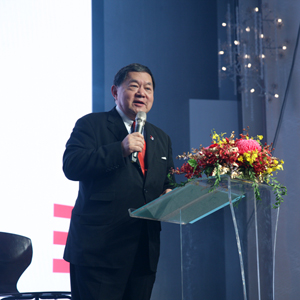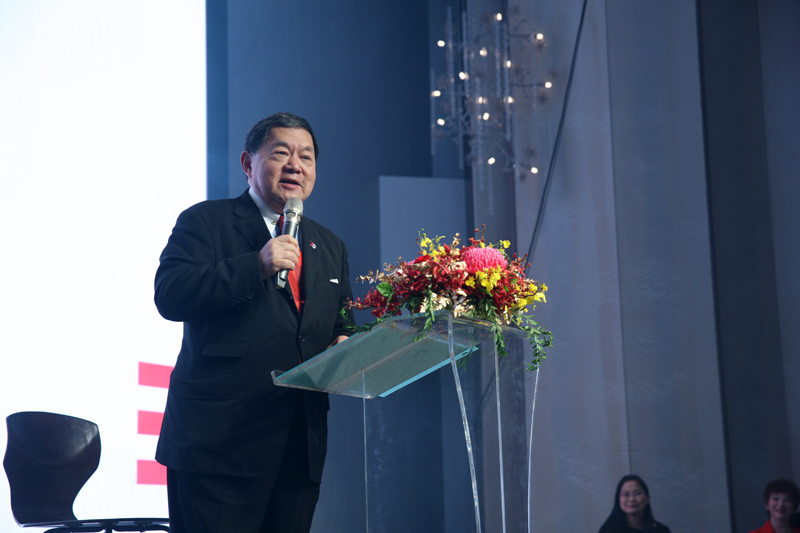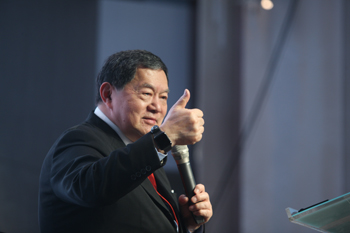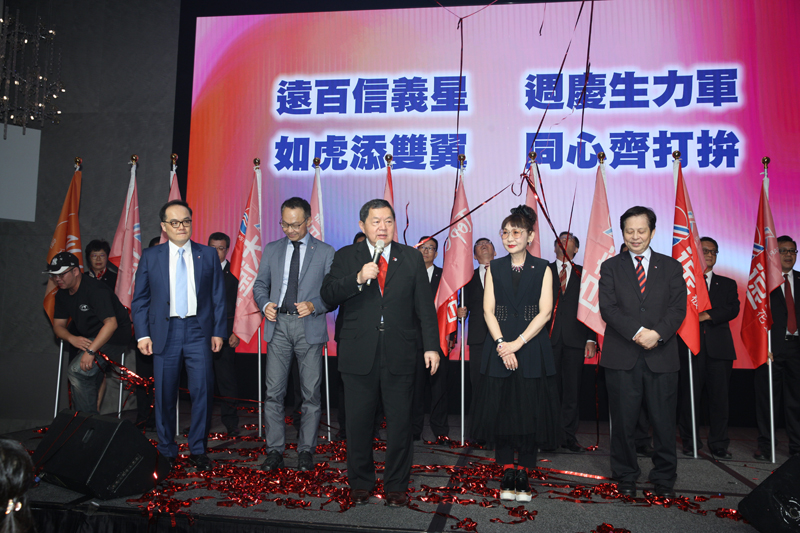12.2019 Leader's Remarks
Retail, Reimagined──Chairman Douglas Hsu’s Speech at Far Eastern Department Stores Vendors’ Party
Far Eastern New Century / Morris Yang


Here comes the season that we all welcome - the start of anniversary sales. We would like to take this precious chance to express our gratitude to you, the vendors of Far Eastern Department Stores, for your efforts and assistance over the past twelve months underpinning our growth. Today, we will briefly review, first, the global economic environment and, second, Taiwan’s retail market. Finally, we will touch on the future of the new consumption era, and lead you to reimagine the future of the retail industry based on retail’s development journey over the past decade.
Ⅰ.Global Economic Prospects
IHS Markit, the global information provider, forecasts the world economy will have grown 2.77% in 2019, edging down from 3.19% in 2018 due to the global economic slowdown. Both developed countries and emerging markets have been impacted by U.S. trade policy under President Donald Trump that has led to trade barriers becoming a foreign policy tool for many countries. According to OECD statistics, protectionist trade measures have led to a stalling of global trade growth, increased business uncertainty, while risking long-lasting harm to investment, and further global economic deceleration.
Looking at the global economy, geopolitical risk is the largest black swan that most every nation and industry is facing. For example on the geopolitical front, a non-deal Brexit would bring with it significant costs. The United Kingdom’s Office for Budget Responsibility estimates that a non-deal Brexit would negatively impact exports, reduce European countries’ dependency on the U.K. for exports, and trigger volatility around the British pound. Likewise in Asia, specifically in Hong Kong, the Anti-Extradition Law Amendment Bill movement in Hong Kong has escalated into unprecedented social unrest. With the ongoing protests, Hong Kong might lose its unique position and competitive advantage as a global financial center. Also, on the high seas, British tankers were seized by Iran and vice versa. Iran threatened to close down the Strait of Hormuz, a channel that transports one-third of the world’s transported oil supply. This threatened to lead to a broader military conflict, thus affecting the global economy.
In addition, after Japan announced in July that it would strengthen its exports controls with regard to South Korea, the close bilateral relations that have existed between Japan and South Korea caused concern for many Japanese and South Korean companies, alike. Given a background of difficult historical problems between Japan and South Korea, pro-North Korean overtures by the South Korean government and general skepticism led to further geopolitical uncertainty. This coupled with President Trump labelling China a currency manipulator, and putting pressure on the U.S. Federal Reserve to lower interest rates further, thus depreciating the U.S. dollar and underpinning U.S. exports, heightens the chances of a currency war that would weight on investor confidence.
Given such elevated economic uncertainty and the difficulty of controlling risk, major corporations have turned more conservative regarding industrial, manufacturing and capital spending decisions, going forward. IHS Markit forecasts the world economy will expand 2.67% year on year in 2020, down slightly from that of 2019, with a key growth driver coming from a forecast rebound in emerging markets’ economic growth in 2020.

The Taiwan economy is forecast to have grown 2.06% in 2019, following relatively flat growth in the first half of 2019 followed by what is expected to be greater than 2% growth in the second half. Private consumption, as a key pillar of Taiwan’s economic growth, is forecast to grow 1.79%, down from 1.99% in 2018, contributing 0.98 percentage point or almost half of Taiwan’s forecast economic growth in 2019. Moreover, domestic investment continues to grow at a forecast 6.36% in 2019, contributing 1.21 percentage points to Taiwan growth. Taiwan government expenditures are forecast to grow 10.15% year on year in 2019 while public sector investment grows 7.5%. With steady economic growth momentum, Taiwan’s consumer price index (or CPI) is forecast to remain stable (at around 1%).
Reviewing retail sector developments over the first eight months, Taiwan’s overall retail performance is down slightly from the same period last year. Statistics show that consolidated merchandise retail revenues grew 4.56% year on year, among which department store revenues grew 5.67% compared to the same period of last year, non-store revenues rose 5.3%, and food & beverage sales revenues increased 5.4% year on year, demonstrating the potential growth momentum of both online and offline retailing. Coupled with fresh food delivery, the total growth in food and beverage is quite remarkable.

With Taiwan’s economic and retail industry outlook in mind, let us move to discussion of the developments in retailing. Reviewing top retail headlines and statistics in 2019, keywords include brick stores, personalization, social media, logistics distribution channels, and Google search.
Next, an analysis of important retail development trends we want to remember back to 2012 when consumption was survival-centric focused on quick convenience, then it evolved into enjoyment-centric in 2014 focusing on living quality. Recently, we see the trend is towards personalized consumption and the consumer pursuing personalized merchandise and services.
However, the key factor to facilitate personalization of merchandise and services comes from innovative technologies. For example, applying smart manufacturing via the internet, promoting a “small quantity, multiple batch” production mode, and introducing new business models for sales, services, logistics, distribution, and payment. Not only services, but the manufacturing industry is also impacted strongly. For example, in the past, production (start-to-finish) was only a loop, and cooperation between upstream and downstream was fixed with simple and single coordination. Smart manufacturing makes for an increasingly blurred border between traditional production and the customer. The production loop no longer focuses on the process itself, but on the customer’s personalized needs, product design, resource integration, and web coordinated production.
Driven by personalized services, the coverage of services becomes wider under the new consumption era. Children, housewives, community residents, elders, young families, college students, single women and men, special consumption groups (families with pets, local people with special hobbies) are all service targets worthy of attention. Among which, people with steady income and core purchasing power tend to be socially-active, enjoy the consumption experience, focus on the content of the product (or service) bought, and pursue their own style with regard to personalized and trendy consumption making use of various Internet of Things (IoT) tools.
Every consumption era is different and focuses on different consumption targets. Today’s consumer focuses on food, home and travel which are also their major spending items. Meanwhile millennials, people born between 1981 and year 2000, have considerably increased their spending focused on elevating their quality of life.
In addition to promoting technology advancement, today’s changing social structure and the responding retailing strategies are all factors resulting in the retail industry’s transformation. In terms of demographics, the ratio of middle-age and elderly people and their overall consumption spending will continue to increase. The younger generation is still the main driving force behind consumption, however. Furthermore, disposable income is an important index of overall economic development and an important metric of the quality of economic growth. Taiwan’s disposable income has been growing steadily, reflecting Taiwan’s solid overall economic development, which in turn has helped drive innovation in the new consumption era. Stronger disposable income and stronger consumption expenditure per capita are combining to boost Taiwan’s economic development.
To reiterate, personalized consumption is the new important trend. If retailers can provide merchandise to the optimal target customer groups, then they not only greatly uplift the member’s shopping experience, but also offer greater incentives that build customer loyalty. In other words, the first priority for retailers is to understand a member’s profile with precision.
The goal of any industry has always been to understand customer profiles as precisely as possible and to provide satisfactory if not superior products and/or services. In the new consumption era, brands today are competing on the basis of who best understands, responds to, and manages their members; who captures precisely their member profiles, and who communicates best with one’s members. Understanding these three elements of understanding, communicating, and managing is a core competence for transformative revenue and brand growth. Retailing in the new consumption era must strive to promote and expand both the accumulation and scope of a retailer’s membership cards, enhance points- accumulation, promote points-redemption, and enhance the coordination and cooperation among all stakeholders within our strategic alliances. Far Eastern Group’s strategic retail effort is focused on increasing customer adherence and loyalty. The Group’s HAPPY GO Card plays such a role of integrating relevant services within the Group and bringing customers closer to the Group through points-accumulation, points-redemption, and e-payment.
Considering our ever-evolving consumption patterns, we must endeavor to connect all consumption scenarios. Only through a 360-degree connection of the industry chain and integration of data analytics can we know our consumers better, understand our customers comprehensively, and then precisely respond to consumers’ personalized needs. Our retail industry needs therefore to invest in constructing its own data analytics infrastructure, elevate its own ecosystem, and gather data from both upstream and downstream enterprises, and customers, in order to upgrade its production and sales supply chain as key to successful retail operations.
Of course, aside from seizing the new era consumption trend, still many good business practices need to be optimized. These include:
1. Good Products/Services
2. A Fantastic Team
3. Best in Class (Technology)
4. Large Market with Customer Willing to Pay
5. Sustainable Business Model, Strong Execution, Robust Processes & Financial Discipline
6. Agility and Adaptability
7. Understand Big Data, AI/Analytics, Cloud, IoT, and Security
8. Environmentally Friendly
Last but not least, let me share with you some words of wisdom from André Gide, winner of the Nobel Prize in Literature in 1947: “One does not discover new lands without consenting to lose sight of the shore for a very long time.” If you want to search for new business opportunities, you must leave the known shores, though not knowing what will happen in the future, you must prepare well to move forward. I hope that everyone is able to deliver remarkable, innovative performances in our new consumption era!#


















